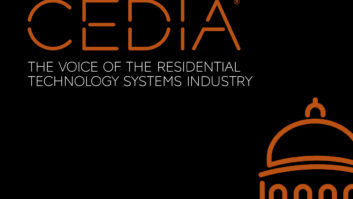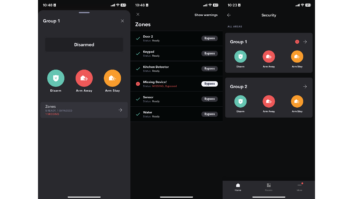
Participants in the Lincoln Tech EST program, in Mahwah, NJ, proudly wave the EST banner. Now that the economy has rebounded, new construction is starting to happen, and the best integrators have weathered the worst of the storm, a new challenge has emerged almost universally across the industry: how to find qualified individuals to do the work. We at CEDIA headquarters hear it almost daily, and especially when groups of members gather, such as at the recent Business Xchange.
Back in the early days of the industry, integrators hired people and trained them on the job. They came from 12-volt, electrical work, just about anywhere. But today, unfortunately, many are resorting to luring talent from the competition, or just subcontracting as needed. There has to be a better way…
What we are hearing is that integrators would like to be able to hire people who have already had some training, and can be productive more quickly, such as returning military veterans, graduates from career centers and tech schools, or even someone who has self-taught themselves the fundamentals and is eager to learn more.
The good news is that help is on its way. CEDIA recognizes the challenge and has been working hard to take action to help build that pipeline of qualified individuals to serve in our industry in a variety of roles, from the basic entry-level tech to more advanced positions. Let’s look first at the basic jobs.
ESPA (Electronic Systems Professional Alliance)
ESPA was created in 2006 (see “Short History” at the end of this article) as a way to establish industry-recognized training and certification for entry-level Electronic Systems Technicians (ESTs). When hiring entry-level ESTs, look for the ESPA certification first. It can be earned by a technician as part of a tech school or career center program or on their own. These people will probably want to be technicians, working with their hands and learning as they go. This program is now in more than 15 markets, mostly east of the Mississippi, and growing rapidly.
The body of knowledge accumulated in this program is basic: construction methods, electricity, tools, cabling, and safety. The certification can be earned through self-study, but a school environment is highly preferred (more hands on, more comprehensive). CEDIA, NSCA, and CEA are co-founders of this program and both CompTIA and ESA are officially supporters. After all, its curriculum supports all kinds of low-voltage work, including commercial, residential, cable, satellite, and security.
CEDIA’s Resources

The Fundamentals of Residential Electronic Systems book is a comprehensive introduction to the industry, from soup to nuts. The ESPA program is a solid initiative, which supports many different career verticals. But last year, CEDIA simultaneously launched a book and certification which will, in the longer run, be key to our ability to attract and train a great pool of talent specifically for our channel. The Fundamentals of Residential Electronic Systems book is a comprehensive introduction to the industry, from soup to nuts. It covers a little bit of everything, without getting too deep or too technical. It is the perfect introduction to the industry for a student, career changer, military vet, or even a hobbyist that is thinking about turning their passion into a career. Sales of this book have been brisk ever since its introduction, and it is clear that there was a real demand for it. Now we are seeing schools seriously look at it as a classroom resource.
The current younger generation has all the “right stuff” to succeed in residential systems. They are already adept at computer applications and mobile devices. Many, especially those involved in high school programs like robotics, even have experience writing code. What is missing is an awareness of the great career opportunities there are, from technician to project manager to programmer. Once they are exposed to the industry, they are hooked. I have been promoting electronic systems as a career for nearly eight years, and it is remarkable to see their faces light up when they realize that there are real careers doing what we do.
Onboarding
Once you have hired someone, you want to make them productive as quickly as possible. Whether they have had prior training or not, CEDIA can help. The Fundamentals book is the place to start, regardless of their background, and earning the Gateway certification will prove their mastery of the basics. For more interactive learning, there are now more than 40 self-paced e-courses available at www.cedia.net.
Your Role in This
These programs are great, but if we want to create a talent pool that really makes a difference, we need them in place in every major market. That’s where you, the integrator, can help. Let us know if there’s a career center or tech school in your market where either ESPA or CEDIA training could be used to enhance an electronics, electrical, or IT program. We will follow up with everything they need to see that there are real jobs waiting for qualified people, right now. And when they realize there is a demand, they will want to help fill that gap by providing the right training and certifications. The programs are there. Now we just need your help to get one launched in your back yard.
Jeff Gardner is CEDIA director of certification and workforce development.
A Short History of ESPA
The CEA, CEDIA, and NSCA founded ESPA in 2006 to meet the increasing demand for properly trained electronic systems technicians. The industry felt the need for a comprehensive and consistent approach for training these techs, and the founding organizations tapped into their network of experienced educators and innovators who created the ESPA curriculum and Job Task Analysis. The curriculum covers five key domains: Electrical Basics, Tools, Construction Methods and Materials, Wiring and Installation Practices, and Standards, Codes and Safety Practices. Students of the program must pass a proctored exam to earn ESPA Certified-EST credentials. To learn more, visit www.espa.org.







